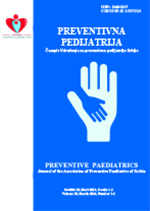PROTECTING CHILDREN FROM ABUSE AND NEGLECT – PEDIATRIC APPROACH
DOI:
https://doi.org/10.46793/PP250213004AKeywords:
abuse, neglect, suspicion, protectingAbstract
Child abuse and neglect includes physical, sexual, emotional abuse, neglect and exploitation of children, which lead to damage to the health or threaten the dignity of the child. It is also generally referred to as violence against children. Four groups of factors are most often mentioned (parental characteristics, sociocultural factors, environmental factors and child factors) that increase the risk of child abuse and neglect. There are no characteristic anamnestic data and clinical signs of abuse, but there are data and signs that can indicate this problem with high probability. Pediatricians and nurses are often among the first to whom a child or their relatives turn for help. In order to achieve the goals of protecting children from abuse and neglect, it is necessary to establish good cooperation between experts from all fields that work with children (health, education, social protection, police, justice and others). However, it should be remembered that abuse can occur in all environments and that the child is never at fault. It is necessary to recognize risk factors, take care of the abused child and report suspected abuse and neglect, but also to help prevent re-victimization and chronic consequences associated with adverse childhood experiences.
References
World Health Organization: Report on consultation on child abuse prevention, 29-31 March 1999, Geneva, World Health Organization, 1999. (document WHO/ HSC/PVI/99.1)
Opšti protokol za zaštitu dece od zlostavljanja i zanemarivanja. Zaključak Vlade Republike Srbije 05 broj: 011-5196/2005 od 25. avgusta 2005.
Stirling J, Gavril A, Brennan B, et al; American Academy of Pediatrics, Council on Child Abuse and Neglect. The Pediatrician’s Role in Preventing Child Maltreatment: Clinical Report. Pediatrics; 2024.
Posebni protokol sistema zdravstvene zaštite za zaštitu dece od zlostavljanja i zanemarivanja. Beograd: Ministarstvo zdravlja 2009.
Cicchetti, D. i Manly, J. T. Editorial: Operationalizing child maltreatment: Developmental processes and outcomes. Dev Psychopathol 2001; 13:755-75.
Pejović Milovančević M, Minčić T, Kalanj D. Priručnik za primenu posebnog protokola sistema zdravstvene zaštite za zaštitu dece od zlostavljanja i zanemarivanja. Beograd: Institut za mentalno zdravlje 2014.
Opšti protokol za zaštitu dece od zlostavljanja i zanemarivanja. Beograd: Ministarstvo za socijalnu zaštitu 2005.
U.S. Department of Health and Human Services, Administration for Children and Families, Administration on Children, Youth and Families, Children’s Bureau. Child maltreatment 2012 [online]. Washington, DC: Government Printing Office; 2012. Available from: http://www.acf.hhs.gov/ sites/default/files/cb/cm2012.pdf
Kocijan Hercigonja, D. Fizičko zlostavljanje. U: Buljan Flander G, Kocijan Hercigonja D, urednici. Zlostavljanje i zanemarivanje djece. Zagreb: Marko M. usluge d.o.o., 2003; 37-63.
Herring JA: Child abuse. In: Herring JA. Tachdjian’s Pediatric orthopaedics, 4th ed, Philadelphia: Elsevier; 2018. Section VI Injuries, Chapter 40, p.33-35.
Beaty JH, Kasser JR: Childe abuse. In: Rockwood & Wilkins' Fractures in Children, 6th Edition, Lippincott Williams & Wilkins; 2006. Section I Basic Principles, Chapter VII, p.223-53.





